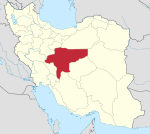Khomeyni Shahr
Khomeyni Shahr
خمينی شهر مهربین Mehrbin | |
|---|---|
City | |
 | |
| Coordinates: 32°42′01″N 51°31′16″E / 32.70028°N 51.52111°E | |
| Country | |
| Province | Isfahan |
| County | Khomeyni Shahr |
| Bakhsh | Central |
| Population (2016 Census) | |
| • Urban | 247,128 [1] |
| Time zone | UTC+3:30 (IRST) |
| • Summer (DST) | UTC+4:30 (IRDT) |
Khomeyni Shahr (Persian: خمينی شهر, also Romanized as Khomeynī Shahr and Khomeynīshahr; from the 1930s until 1979, known as Homāyūnshahr or Homayoon Shahr (همایونشهر); known as Sedeh (سده) prior to the 1930s)[2] is a city and capital of Khomeyni Shahr County, Isfahan Province, Iran. At the 2006 census, its population was 218,737, in 57,551 families.[3]
Khomeyni Shahr is now part of the Isfahan Metropolitan area.
The town was originally known as Sedeh. In the 1930s, the name was changed to Homayunshahr. After the Iranian Revolution of 1979, the city was renamed again to Khomeyni Shahr (meaning "City of Khomeyni"), in honor of Ayatollah Khomeini. Locals have continued to refer to the city as Sedeh. There has been an ongoing effort to rename back the city's name to its historical one Mehrbin (مهربین).
History
This article needs additional citations for verification. (December 2008) |
It is commonly believed that the original name, Sedeh (Persian: سده), is derived from Seh-dedge, meaning "three castles" in Persian, ("dedge" (دژ) means "castle"), and is linked to the formation of the town by the growth of three neighbouring castles. The three main castles of Kohan Dedge, Gar Dedge, and .... Dedge (locally pronounced kohan dedge, gar dar and ...).
It is commonly believed that Seh-dedge was a Sassanian military base and an old fireplace (atash gah) based on top of the mountain near the town.
The three main villages of Khouzan (locally pronounced Khizoon), Foroushan (the origin of Foroushan was Parishan (pari (angel) + voshan (face))), and Varnosfaderan (Venesfohoon) remain identifiable parts of the city. However, there are in fact five former villages forming identifiable parts of the town. This has led to the argument that the name may be linked to the ancient Persian festival of Sadeh.
The name change to Homayunshahr took place during the reign of Reza Shah Pahlavi. The name literally means "auspicious or august city", but Homayun was also a title of the Shah and so the name was seen as being linked with the Pahlavi dynasty. Thus, after the revolution of 1979, the city was renamed again, this time to be called after Ayatollah Khomeini, the leader of the revolution.
University
The Islamic Azad University of Khomeinyshahr is one of the most promising Iranian universities in various fields, especially in mechanical and electrical engineering.
Isfahan University of Technology (IUT) is ranked as one of the best universities in Iran.
The city contains many historical buildings and is a good place to welcome tourists. One of the most beautiful historical buildings is Sartip's house located in downtown.
References
- ^ https://www.amar.org.ir/english
- ^ Khomeyni Shahr can be found at GEOnet Names Server, at this link, by opening the Advanced Search box, entering "6013273" in the "Unique Feature Id" form, and clicking on "Search Database".
- ^ "Census of the Islamic Republic of Iran, 1385 (2006)" (Excel). Statistical Center of Iran. Archived from the original on 2011-09-20.


